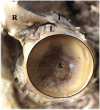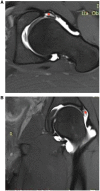Graft choices for acetabular labral reconstruction
- PMID: 30647922
- PMCID: PMC6328747
- DOI: 10.1093/jhps/hny033
Graft choices for acetabular labral reconstruction
Abstract
The acetabular labrum plays a key role in maintaining hip function and minimizing hip degeneration. Once thought to be a rare pathology, advances in imaging have led to an increase in the number of diagnosed labral tears. While still a relatively new field, labral reconstruction surgery is an option for tears that are irreparable or require revision after primary repair. Various autograft and allograft options exist when considering labral reconstruction. The first labral reconstruction surgery was described using the ligamentum teres capitis, and has since evolved, incorporating more graft sources and reconstructive techniques. The purpose of this review is to assess and describe the different graft sources and technique currently implemented by hip surgeons. Moreover, this review attempts to determine whether a single labral reconstructive graft type is superior to the others. Techniques using the Ligamentum teres capitis autograft, ITB autograft, gracilis autograft, quadriceps tendon autograft, capsular autograft, semitendinosus allograft, indirect head of the rectus femoris autograft, peroneus brevis tendon allograft and Tensor fascia lata allograft were found. Scoring was available on 5 out of the 9 graft types. The advantages and disadvantages of each graft source is described as a comparative tool. No single graft type has shown increased benefit in acetabular labral reconstruction. The lack of uniform outcome measurements hinders comparison of reported outcomes. Surgeons should make an informed decision based on their experience as well as the patient's history and needs when choosing which graft type would be best suited for their patients.
Figures




References
-
- Tan V, Seldes RM, Katz MA. et al. Contribution of acetabular labrum to articulating surface area and femoral head coverage in adult hip joints: an anatomic study in cadavera. Am J Orthop 2001; 30: 809–12. - PubMed
-
- Philippon MJ, Nepple JJ, Campbell KJ. et al. The hip fluid seal–Part I: the effect of an acetabular labral tear, repair, resection, and reconstruction on hip fluid pressurization. Knee Surg Sports Traumatol Arthrosc 2014; 22: 722–9. - PubMed
-
- Tanzer M, Noiseux N.. Osseous abnormalities and early osteoarthritis: the role of hip impingement. Clin Orthop Relat Res 2004; 429: 170–7. - PubMed
-
- Safran MR. The acetabular labrum: anatomic and functional characteristics and rationale for surgical intervention. J Am Acad Orthop Surg 2010; 18: 338–45. - PubMed
-
- Toomayan GA, Holman WR, Major NM. et al. Sensitivity of MR arthrography in the evaluation of acetabular labral tears. Am J Roentgenol 2006; 186: 449–53. - PubMed
Publication types
LinkOut - more resources
Full Text Sources

